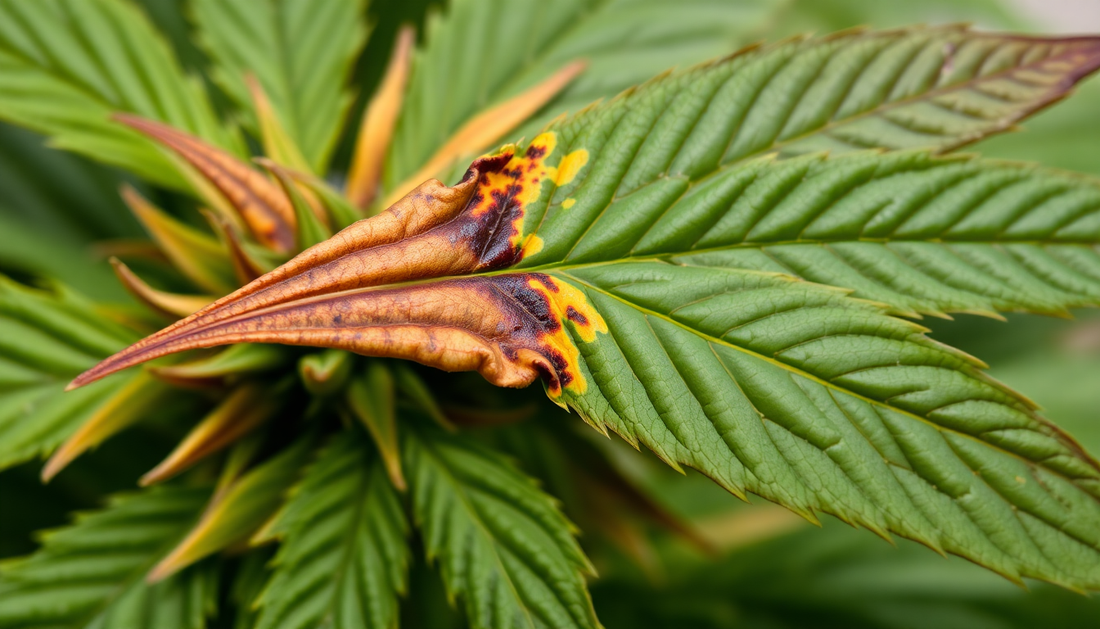
How to Fix Cannabis Nutrient Burn: A Step-by-Step Guide
Nutrient burn is a common problem for cannabis growers, especially for those just starting out. It occurs when plants receive too many nutrients, resulting in damaged leaves, stunted growth, and reduced yields. If left untreated, nutrient burn can seriously affect your plant’s health and the quality of your harvest. The good news is that nutrient burn can be fixed with the right steps and care.
This guide will help you identify nutrient burn, understand its causes, and learn how to correct it to restore your plants to full health.
What Is Nutrient Burn?
Nutrient burn, also known as “nute burn,” happens when cannabis plants receive an excess of nutrients—particularly nitrogen. This overload causes chemical imbalances that damage the plant’s tissues, starting with the leaves. Although nitrogen is crucial for vegetative growth, too much of it (or other nutrients) can harm the plant.
Common Causes of Nutrient Burn
- Overfeeding: Adding too much fertilizer or following a feeding schedule with overly high concentrations of nutrients.
- Incorrect Nutrient Ratios: Using fertilizers with unbalanced N-P-K (nitrogen, phosphorus, potassium) ratios can lead to nutrient overload.
- Build-Up in Soil or Medium: Nutrients can accumulate over time in the growing medium, especially in soil or coco coir, leading to toxic levels.
- Hydroponic Mismanagement: In hydroponic systems, nutrient concentrations can spike quickly if not monitored regularly.
How to Identify Cannabis Nutrient Burn
Early detection is key to preventing long-term damage. Here are some signs to look for:
1. Burnt Leaf Tips
The most common symptom is the yellowing or browning of leaf tips, giving them a burnt appearance. This usually starts at the top of the plant and gradually affects more leaves.
2. Dark Green Leaves
Excess nitrogen often causes the leaves to turn dark green and become overly lush before showing signs of burn.
3. Curling or Clawing Leaves
The leaves may curl downward (clawing) as they become overloaded with nutrients.
4. Crispy or Dry Texture
Burned leaves become dry, crispy, and brittle. In severe cases, the affected leaves will die and fall off the plant.
5. Stunted Growth
Nutrient burn can halt new growth, leaving your plant small and underdeveloped.
How to Fix Nutrient Burn in Cannabis Plants
Once you’ve identified nutrient burn, it’s important to act quickly to prevent further damage. Follow these steps to fix nutrient burn and restore your plant’s health:
1. Flush the Growing Medium
Flushing is the first and most important step in fixing nutrient burn. This involves running clean, pH-balanced water through the growing medium to remove excess nutrients.
- For Soil: Flush with 2–3 times the volume of the pot size using pH-balanced water (pH 6.0–6.8). Allow the water to drain completely.
- For Coco Coir: Flush with pH-balanced water (pH 5.5–6.5) and ensure proper drainage to avoid waterlogging.
- For Hydroponics: Replace the nutrient solution with pure, pH-balanced water and run the system for 24 hours before reintroducing nutrients.
2. Adjust pH Levels
Maintaining the correct pH is crucial for nutrient uptake. If the pH is too high or too low, it can worsen the problem. Test and adjust the pH of your water and growing medium:
- Soil: Keep the pH between 6.0 and 6.8.
- Hydroponics/Coco Coir: Maintain a pH range of 5.5 to 6.5.
3. Reduce or Stop Nutrient Feeding
After flushing, avoid feeding your plant any nutrients for at least one week. This gives the plant time to recover and prevents further damage. When you resume feeding, start with a diluted nutrient solution (50% strength) and gradually increase as needed.
4. Remove Severely Damaged Leaves
Trim off any leaves that are completely dead or severely burned. This helps the plant focus its energy on new growth and prevents potential infections from decaying plant material.
5. Monitor and Adjust Feeding Schedule
Once your plant has recovered, adjust your feeding schedule to prevent future nutrient burn. Follow the manufacturer’s instructions on nutrient products and avoid overfeeding. Less is often more when it comes to cannabis nutrients.
Preventing Nutrient Burn in the Future
Prevention is always better than cure. Here are some tips to avoid nutrient burn in your cannabis plants:
1. Use a Light Feeding Schedule
Start with half the recommended nutrient dose and gradually increase based on your plant’s response. Many nutrient companies recommend high doses that may not be suitable for all plants.
2. Monitor pH Regularly
Check the pH of your water and growing medium frequently to ensure it stays within the optimal range for cannabis.
3. Use High-Quality Nutrients
Choose cannabis-specific nutrients that are balanced and designed for different stages of growth. Avoid using general-purpose fertilizers.
4. Flush Periodically
Even if your plants appear healthy, flushing every 4–6 weeks can help prevent nutrient buildup and reduce the risk of nutrient burn.
5. Monitor for Early Signs
Keep a close eye on your plants and respond quickly to any signs of stress. Early detection can prevent small problems from becoming major issues.
Conclusion
Nutrient burn can be a serious problem for cannabis growers, but with the right approach, it’s easy to fix and prevent. The key is to act quickly by flushing the growing medium, adjusting pH levels, and reducing nutrient concentrations. By monitoring your plants closely and following a balanced feeding schedule, you can avoid nutrient burn and ensure your cannabis plants stay healthy and productive throughout their life cycle.
